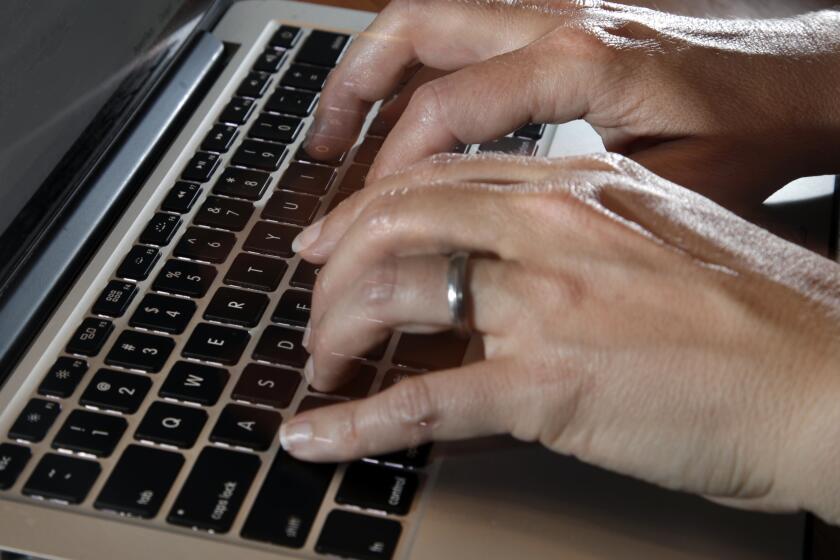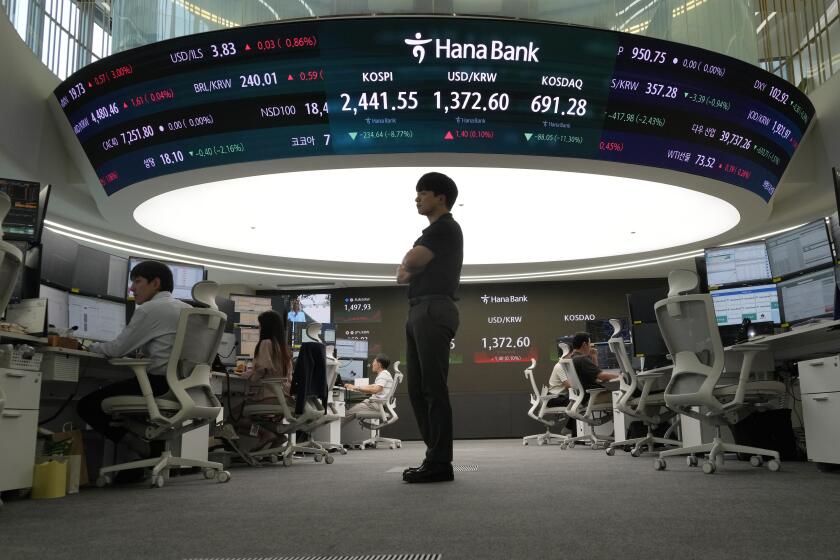Is your company secretly monitoring your work at home? Since COVID, the practice has surged

WASHINGTON — Despite evidence that working from home has not diminished U.S. productivity during the pandemic, employers are increasingly turning to monitoring software that can track workers’ keystrokes, log active hours, take regular screenshots and even activate a web camera.
And many companies may be using such tracking systems without workers’ knowledge.
Gartner, a technology research and consulting firm, estimates that 60% of large corporations now employ monitoring software, double the share of early last year.
Teramind, a Miami-based provider of employee-monitoring software, said that before the pandemic, about 70% of its sales came from companies concerned about security and 30% from those focused on worker productivity. That balance has since flipped, said Eli Sutton, Teramind’s vice president of operations.
“They want to make sure productivity stays high. It’s essentially become the new norm,” Sutton said, noting that Teramind’s sales tripled early in the pandemic and have not slowed.
Software programs run the gamut in degree of invasiveness and data collected. Most can be cloaked in secrecy.
Most surveys and economic reports show U.S. productivity did not suffer when American workers began doing their jobs from home. During the pandemic, Americans on average spent 40% of their work hours at home, compared with 5% in February 2020.
Yet U.S. productivity growth since the health crisis has run at more than double the rate it had in the decade before the spread of COVID-19 and surge of remote work.
And for more than 85% of employers, work-from-home efficiency met or exceeded their expectations, with half of these companies saying it has been “substantially” or “hugely” better, according to research work by economists at Stanford and the University of Chicago.
Many companies justify the surveillance on grounds that it helps them improve employees’ performance. Elizabeth Harz, chief executive of InterGuard, said her firm’s monitoring tools can help managers identify burnout, overwork and tasks where people may be getting stuck.
“A category that started more as perhaps the Big Brother notion is evolving to be much more positive, transparent and helpful to both employers and employees,” she said.
But Brian Kropp, Gartner’s chief of human resource research who has been surveying companies, said that “most employers have not told their employees they’re doing this, which actually creates a real problem.”
ExpressVPN, in a recent study with Pollfish, found that 1 in 5 employers aren’t likely to tell employees about installing monitoring software.
“There is a significant gap between what employers are actively monitoring and what employees think their employers are monitoring,” said the virtual private network service.
A $100,000 signing bonus for a veterinarian? COVID has changed American work life, with employees asking for more, and employers obliging.
When the pandemic shut down the Atlanta offices of Floyd County Productions last year, Jennifer Garcia suddenly found herself working full-time from home.
She and her co-workers were notified in May 2020 that Floyd, an animation studio, was employing a new app to facilitate remote work and that it was being loaded onto work computers.
Garcia, an IT systems specialist, said she wasn’t happy when she learned that the software could track employee activity and take screenshots without alerting workers. So she took extra precautions when looking at personal emails or other private material on her work computer. In April, Garcia quit after nearly 10 years with the studio, in part because she didn’t trust how the company might use the new software applications.
“Because I have more technical knowledge, I was able to set up a system where I could switch very quickly between different computers and not be slowed down,” said Garcia, 39, who now works as a software engineer for another firm in Atlanta.
“But I can see how if you’re not as technically inclined or maybe you don’t have an extra computer at home that you could use for personal stuff, you’re just kind of subject to the whims of your employer.”
Patrick Piper, director of business affairs at Floyd County Productions, said the company “does not perform any micro-monitoring of day-to-day employee activity.” Nor does it secretly grab screenshots from employees, he said in an email reply.
“Floyd County Productions does perform ‘activity monitoring’ in the professional sense of protecting our networks, the intellectual property of our clients and overall progress of our productions,” Piper said.
The number of companies using ‘bossware’ has skyrocketed during the pandemic. Here’s how to find out if your company is monitoring you.
He added that the company not only notified workers of the new software but requires employees to read and sign off on the IT policy. He declined to provide a copy of the policy or the notification email.
Using monitoring programs is nothing new for large companies. The telecommunications firm Vonage, for example, began tracking its salesforce when it went virtual before the pandemic. The company declined to comment.
Other firms didn’t respond to requests for information or were vague about their usage.
Verizon is listed as a user of Time Doctor’s tracking software, but Verizon’s communications staff didn’t respond to interview requests for this story.
Keller Williams, a large real estate franchise firm and Time Doctor customer, said that it couldn’t comment because the technology is not something that’s used throughout the enterprise.
Some companies are experimenting with other, less high-tech ways to keep track of workers at home.
Mattel recently announced, and quickly retracted, a plan in which bosses could make unannounced at-home visits to remote customer service agents at its American Girl unit.
A company spokeswoman said the purpose was to ensure that employees working from home were properly and securely handling customer orders and customer information.
“We removed the line about any unplanned visits because it was an activity that was never put into practice,” the spokesperson said.
Like Garcia, many workers view the monitoring as a violation of privacy and unnecessary. And even though U.S. law gives employers wide latitude to track their employees’ work and their activity on company equipment, the sudden bulge of teleworkers — and efforts by employers to manage them — has raised a range of concerns.
“It’s a big bargaining issue, which is, ‘Are you going to trust me to perform? And can we look at my output and not surveil my time?’” said Mary Kay Henry, president of the Service Employees International Union, which represents thousands of clerical workers.
Advocates for employee rights worry that employers will use electronic monitoring data for performance reviews and to fire workers.
“A moment’s pause or tiny misstep can now be detected by the employer,” said Irene Tung, a policy analyst at the National Employment Law Project. “When you add these new surveillance technologies, it makes the need for a transparent and fair disciplinary system all the more urgent.”
Monitoring programs can track the websites workers are on, apps they’re using and their email and social media activity. Some programs allow managers not just to count keystrokes but to read what’s typed and record conversations and video, using a computer’s microphone and web camera.
But even sellers of the software say using a webcam to monitor an employee is going too far and would backfire.
“Especially with people working from home with their children and their families, employers don’t need to be staring at you or your home,” said Harz of InterGuard.
In Illinois, a bill is pending that would limit employers’ use of electronic monitoring for disciplining workers. Massachusetts lawmakers have proposed new sweeping privacy protections that include checks on employee surveillance.
Across the country, however, there are few if any legal limits on employer monitoring.
From the corporate point of view, a primary concern is the controversy that could result from public disclosure of the monitoring. And companies worry about employees’ reaction if they learn about the surveillance.
Tracking workers in secret can damage a company’s reputation and create other complications. Gartner’s Kropp described the hoops one employer jumped through because it wasn’t upfront about what it had been doing.
At a call center, monitoring of remote employees revealed that some workers were most productive in the morning, others in the afternoon. That suggested switching individuals’ work schedules to fit their optimal performance.
But sharing the data justifying the changes would have exposed what the employer had been doing for weeks without workers’ knowledge. So the company decided it had to take a step back and announce the monitoring as if it had just started, and then only later discuss adjusting work hours.
“The company realized that their employees are going to be really upset once they find out that you’ve been tracking them in all these sorts of things while they’ve been working at home,” Kropp said.
To be sure, a wide array of employers for many years have been keeping close tabs on employees’ computer activity, both in the office and at workers’ homes, to protect sensitive information such as health and banking records, business trade secrets and confidential customer data.
What’s different today is the amount of information that employers can capture with tracking software, real-time dashboards and detailed, even minute-by-minute logs of an employee’s workday. And the monitoring cost to the employer? Kropp says it’s as low as $50 to $100 per employee per year.
The names of some of the software sellers are suggestive of what their platforms may be aiming to do, such as StaffCop and CleverControl, neither of which responded to requests for comment.
Nicholas Bloom, an economics professor at Stanford who has long studied remote work, calls employee monitoring programs “creepy” and doesn’t think the trend will last.
He is convinced that most teleworkers will be on a hybrid model. If these workers spend three days a week at company premises, as he expects most will, they will probably do as much of their face-to-face meetings, training and client visits as before the pandemic, Bloom said. The remaining two days, employees will work at home reading, writing and doing other quieter activities.
“Hybrid means none of this monitoring software is really necessary. You can just assess people on those three days a week,” he said.
“In the end,” said Stephen Morrow, co-owner of monitoring software supplier SentryPC, “should a company decide to make this practice part of their policy, the employee is the one who decides if they want to work for the company or continue working for them if they feel strongly offended by it. These are all things the company would and should consider.”
More to Read
Get the L.A. Times Politics newsletter
Deeply reported insights into legislation, politics and policy from Sacramento, Washington and beyond. In your inbox three times per week.
You may occasionally receive promotional content from the Los Angeles Times.














